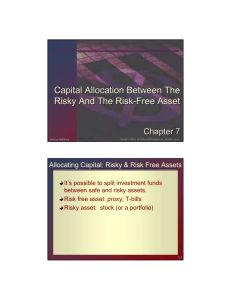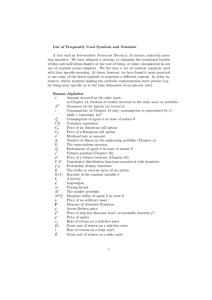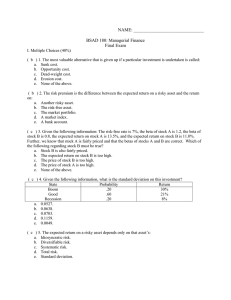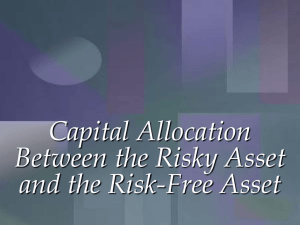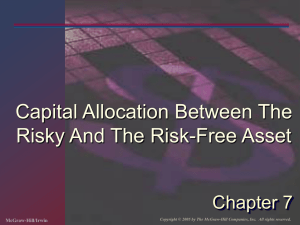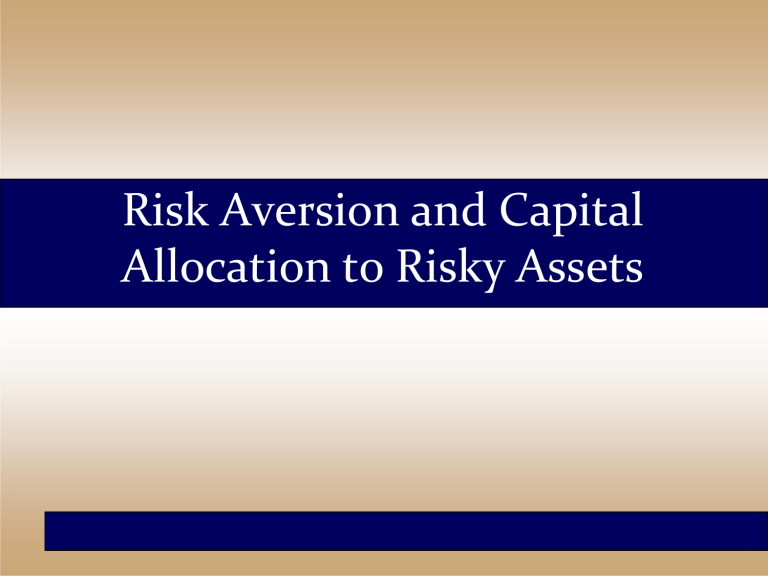
Risk Aversion and Capital Allocation to Risky Assets 6-2 Allocation to Risky Assets • Investors will avoid risk unless there is a reward. • The utility model gives the optimal allocation between a risky portfolio and a risk-free asset. 6-3 Risk and Risk Aversion • Speculation – Taking considerable risk for a commensurate gain – Parties have heterogeneous expectations 6-4 Risk and Risk Aversion • Gamble – Bet or wager on an uncertain outcome for enjoyment – Parties assign the same probabilities to the possible outcomes 6-5 Risk Aversion and Utility Values • Investors are willing to consider: – risk-free assets – speculative positions with positive risk premiums • Portfolio attractiveness increases with expected return and decreases with risk. • What happens when return increases with risk? 6-6 Table 6.1 Available Risky Portfolios (Riskfree Rate = 5%) Each portfolio receives a utility score to assess the investor’s risk/return trade off 6-7 Utility Function U = utility E ( r ) = expected return on the asset or portfolio A = coefficient of risk aversion = variance of returns ½ = a scaling factor 1 2 U E(r) A 2 6-8 Table 6.2 Utility Scores of Alternative Portfolios for Investors with Varying Degree of Risk Aversion 6-9 Mean-Variance (M-V) Criterion • Portfolio A dominates portfolio B if: E rA E rB • And A B 6-10 Estimating Risk Aversion • Use questionnaires • Observe individuals’ decisions when confronted with risk • Observe how much people are willing to pay to avoid risk 6-11 Capital Allocation Across Risky and RiskFree Portfolios Asset Allocation: • Is a very important part of portfolio construction. • Refers to the choice among broad asset classes. Controlling Risk: • Simplest way: Manipulate the fraction of the portfolio invested in risk-free assets versus the portion invested in the risky assets 6-12 Basic Asset Allocation Total Market Value Risk-free money market fund $300,000 $90,000 Equities Bonds (long-term) Total risk assets $113,400 $96,600 $210,000 $113,400 0.54 WE $210,000 $96,600 0.46 WB $210,00 6-13 Basic Asset Allocation • Let y = weight of the risky portfolio, P, in the complete portfolio; (1-y) = weight of risk-free assets: $210,000 y 0.7 $300,000 $113,400 E: .378 $300,000 1 y B: $90,000 0.3 $300,000 $96,600 .322 $300,000 6-14 The Risk-Free Asset • Only the government can issue default-free bonds. – Risk-free in real terms only if price indexed and maturity equal to investor’s holding period. • T-bills viewed as “the” risk-free asset • Money market funds also considered risk-free in practice 6-15 Figure 6.3 Spread Between 3-Month CD and T-bill Rates 6-16 Portfolios of One Risky Asset and a Risk-Free Asset • It’s possible to create a complete portfolio by splitting investment funds between safe and risky assets. – Let y=portion allocated to the risky portfolio, P – (1-y)=portion to be invested in risk-free asset, F. 6-17 Example Using Chapter 6.4 Numbers rf = 7% rf = 0% E(rp) = 15% p = 22% y = % in p (1-y) = % in rf 6-18 Example (Ctd.) The expected return on the complete portfolio is the risk-free rate plus the weight of P times the risk premium of P E(rc ) rf y E(rP ) rf E rc 7 y 15 7 6-19 Example (Ctd.) • The risk of the complete portfolio is the weight of P times the risk of P: C yP 22y 6-20 Example (Ctd.) • Rearrange and substitute y=C/P: 8 C E rP rf 7 22 C E rC r f P Slope E rP r f P 8 22 6-21 Figure 6.4 The Investment Opportunity Set 6-22 Capital Allocation Line with Leverage • Lend at rf=7% and borrow at rf=9% – Lending range slope = 8/22 = 0.36 – Borrowing range slope = 6/22 = 0.27 • CAL kinks at P 6-23 Figure 6.5 The Opportunity Set with Differential Borrowing and Lending Rates 6-24 Risk Tolerance and Asset Allocation • The investor must choose one optimal portfolio, C, from the set of feasible choices – Expected return of the complete portfolio: E(rc ) rf y E(rP ) rf – Variance: C2 y 2 P2 6-25 Table 6.4 Utility Levels for Various Positions in Risky Assets (y) for an Investor with Risk Aversion A = 4 6-26 Figure 6.6 Utility as a Function of Allocation to the Risky Asset, y 6-27 Table 6.5 Spreadsheet Calculations of Indifference Curves 6-28 Figure 6.7 Indifference Curves for U = .05 and U = .09 with A = 2 and A = 4 6-29 Figure 6.8 Finding the Optimal Complete Portfolio Using Indifference Curves 6-30 Table 6.6 Expected Returns on Four Indifference Curves and the CAL 6-31 Passive Strategies: The Capital Market Line • The passive strategy avoids any direct or indirect security analysis • Supply and demand forces may make such a strategy a reasonable choice for many investors 6-32 Passive Strategies: The Capital Market Line • A natural candidate for a passively held risky asset would be a well-diversified portfolio of common stocks such as the S&P 500. • The capital market line (CML) is the capital allocation line formed from 1-month T-bills and a broad index of common stocks (e.g. the S&P 500). 6-33 Passive Strategies: The Capital Market Line • The CML is given by a strategy that involves investment in two passive portfolios: 1. virtually risk-free short-term T-bills (or a money market fund) 2. a fund of common stocks that mimics a broad market index. 6-34 Passive Strategies: The Capital Market Line • From 1926 to 2009, the passive risky portfolio offered an average risk premium of 7.9% with a standard deviation of 20.8%, resulting in a reward-to-volatility ratio of .38.

